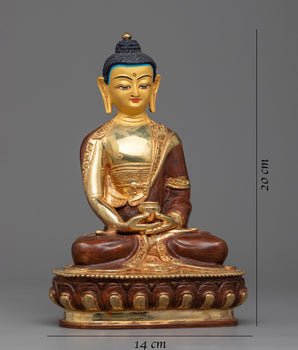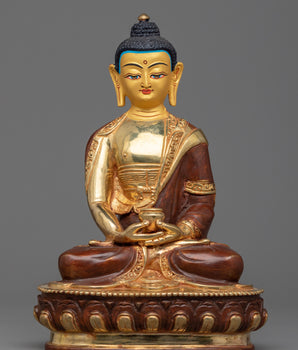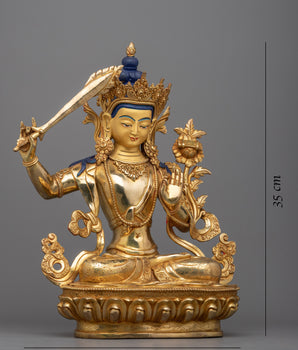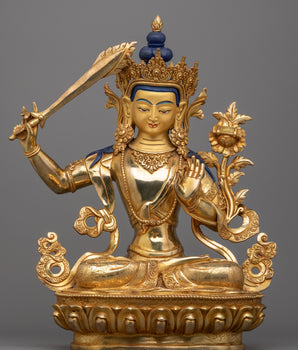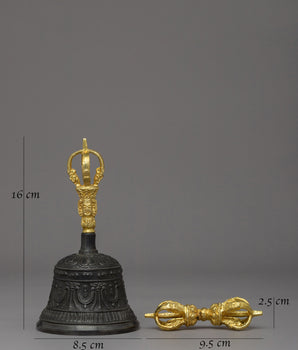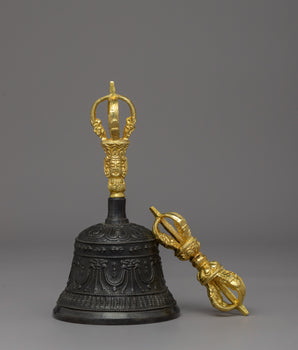Every rug tells a story — a story of the mountains, of heritage, and of craftsmanship passed down through generations. Our hand-knotted rugs from Nepal embody the spirit of the Himalayas, where patience, precision, and passion intertwine to create works of timeless beauty.
Each piece is handwoven by skilled artisans who transform the world’s best quality wool into luxurious textures, designed to last a lifetime.
Click here to View: Tibetan Rug Depicting Citipati
A Journey Through Time: The History of Carpet Making in Nepal
The story of Nepali carpet weaving is as intricate and enduring as the rugs themselves — a tale of culture, craftsmanship, and resilience born in the shadows of the Himalayas.
Origins: A Heritage of Refuge and Resilience (1960s)
The roots of Nepal’s carpet industry trace back to the early 1960s, when waves of Tibetan refugees crossed the Himalayas after the Chinese occupation of Tibet in 1959. These refugees, displaced from their homeland, carried with them centuries-old traditions of Tibetan hand-knotting, known for its spiritual symbolism and remarkable durability.
Initially, these carpets were woven purely for personal and monastic use — simple, functional pieces designed to warm the stone floors of Tibetan homes and monasteries. Their motifs often depicted auspicious Buddhist symbols such as the eternal knot, lotus flowers, or dragons, representing protection, harmony, and strength.
When resettled in Nepal, the Tibetan community began weaving carpets as a means of livelihood, supported by development organizations and NGOs such as the Swiss Agency for Technical Assistance (now Helvetas). These early collaborations helped establish weaving centers in and around Jawalakhel (Lalitpur), which remains one of the most prominent carpet-making hubs to this day.
What began as a refugee craft soon transformed into one of Nepal’s most successful export industries. During the 1970s and 1980s, international demand for Tibetan-style hand-knotted rugs surged, particularly in Europe and North America.
Buyers were captivated by their soft texture, natural wool, hand-spun yarns, and earthy, plant-based dyes — a refreshing contrast to industrial, machine-made carpets. The unique combination of Tibetan weaving techniques and Nepali craftsmanship gave rise to a distinctive new identity: the “Nepali-Tibetan rug.”
By the mid-1980s, Nepali rugs had gained a reputation for being among the finest handmade carpets in the world. Workshops expanded beyond refugee settlements to the Kathmandu Valley, Bhaktapur, and Pokhara, creating sustainable employment for thousands of artisans, many of them women.
This period marked the beginning of Nepal’s global recognition as a center for premium hand-knotted rugs, blending tradition with artistic innovation. 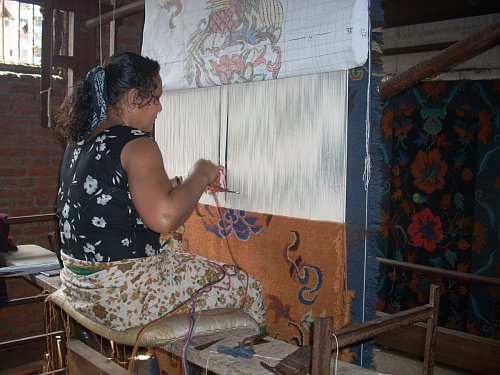
Artistic Evolution and Innovation (1990s–2000s)
As Nepal’s weaving skills matured, the designs evolved too. While early carpets showcased traditional Tibetan patterns and religious iconography, modern artisans began incorporating contemporary and abstract designs to suit international tastes.
The weaving process remained fully handcrafted, but artisans started experimenting with higher knot densities, softer wool blends, and Swiss chrome dyes, ensuring consistency and colorfastness. The collaboration between Nepali weavers and European and American designers gave rise to a new genre of rugs that balanced heritage craftsmanship with modern luxury.
Many prestigious global brands began sourcing from Nepal, helping the industry develop international standards of quality and sustainability.
Modern-Day Excellence: Tradition Meets Design
Today, hand-knotted rugs from Nepal adorn homes, hotels, and galleries across the world — from minimalist penthouses in New York to traditional villas in Europe. They are sought after for their durability, warmth, and timeless beauty, embodying the perfect blend of heritage, quality, and artistry.
What began as a humble refugee craft has become a national symbol of Nepal’s creativity and craftsmanship. Each rug stands as a tribute to the resilience of its weavers, the purity of Himalayan wool, and the spiritual grace of the Himalayas.
From Wool to Wonder: The Making of a Hand-Knotted Rug in Nepal
Behind every hand-knotted rug from Nepal lies an extraordinary journey — one that begins with raw Himalayan wool and ends with a masterpiece woven by human hands. Each stage reflects centuries of tradition, sustainable practices, and the devotion of artisans who treat their craft as both art and heritage.
Let’s walk through the step-by-step process that transforms pure wool into a timeless work of woven beauty.
1. Sourcing the Wool: The Heart of Quality
The process begins high in the Himalayan foothills, where sheep graze freely on alpine pastures. Their thick, resilient fleece — known as Himalayan highland wool — is prized worldwide for its strength, sheen, and softness.
Sometimes, this wool is blended with New Zealand wool to create a perfect balance of durability and luster. The choice of wool determines the rug’s texture, lifespan, and luxury. After shearing, the raw wool is hand-cleaned to remove natural oils, dirt, and debris, while preserving lanolin — the component that gives wool its natural stain resistance and soft feel.
2. Carding and Spinning: Preparing the Fiber
Once cleaned, the wool is carded, meaning it is combed to align the fibers. This creates an even, fluffy texture that’s easy to spin.
Traditionally, spinning was done using hand-spindles (phing) or small wooden wheels, though many modern workshops now use spinning machines for consistency. The result is a long, strong strand of hand-spun yarn, which is both durable and naturally irregular — adding charm and texture to the final rug. ![]()
3. Dyeing: Where Color Comes to Life
The spun yarns are then dyed — a step that defines the rug’s final personality. Nepalese artisans use both natural vegetable dyes (derived from plants, roots, and minerals) and Swiss chrome dyes, depending on the desired finish.
Natural dyes offer earthy, organic tones such as indigo blues, madder reds, and turmeric yellows. Swiss dyes, on the other hand, provide color precision and fade resistance — perfect for modern design palettes.
The dyeing process is done in small batches, ensuring rich, even color. The yarns are dried under the Himalayan sun, giving them a vibrant yet natural glow that machine dyeing simply can’t replicate.
4. Designing: Art Meets Geometry
Every hand-knotted rug begins with a design — a carefully mapped pattern drawn on graph paper, known locally as a naksha. Each square represents a knot, creating a precise visual guide for the weavers.
Designs may be traditional (Tibetan motifs, lotus flowers, geometric borders) or contemporary (abstract art, minimalistic lines, or nature-inspired patterns).
Modern Nepalese workshops often collaborate with international designers, blending traditional symbolism with modern elegance — making each rug not just a household item, but a collector’s piece.
5. Weaving: The Art of the Knot
This is the soul of the entire process. Using vertical wooden looms, artisans meticulously tie each knot by hand around cotton or silk warp threads.
Each rug may contain anywhere between 60 to 200 knots per square inch, depending on the fineness of design and density desired. The more knots, the more detailed and durable the rug.
6. Trimming and Washing: Bringing the Rug to Life
Once weaving is complete, the rug is cut from the loom and trimmed by hand to achieve the desired pile height. Skilled craftsmen use sharp scissors to refine intricate patterns and give the surface a consistent texture.
Then comes washing, a vital stage that enhances the wool’s softness and brings out its natural sheen. Rugs are washed in flowing water — often using biodegradable soap — and dried naturally in the sun. This process also helps the colors settle and the fibers lock in place.
7. Finishing and Quality Check: The Final Touch
After washing and drying, the rug goes through a rigorous quality inspection. Artisans check every inch for uniform knotting, color consistency, and finish. The edges are bound, fringes secured, and the surface lightly brushed for a refined, luxurious appearance.
The rug is then stretched on a wooden frame to ensure perfect shape and flatness — a final step that readies it for homes and galleries worldwide.
8. Packaging and Export: From the Himalayas to the World
Finally, the finished rug is carefully rolled, wrapped in eco-friendly packaging, and shipped from Kathmandu to international destinations. Each rug carries with it the spirit of the Himalayas — a story of craftsmanship, tradition, and sustainable beauty.
Why Invest in a Hand-Knotted Rug from Nepal
In an age of mass production and fleeting trends, a hand-knotted rug from Nepal stands as a rare symbol of authenticity, patience, and artistry. It is not merely a floor covering — it is a piece of living heritage, woven with devotion, tradition, and the natural beauty of the Himalayas.
1. A Testament to Craftsmanship
Every rug is 100% handmade by skilled artisans who dedicate months — sometimes years — to perfecting a single piece. The dense knotting, fine wool, and detailed design ensure unmatched durability and elegance. No two rugs are ever identical; each one carries its own rhythm, story, and soul.
2. A Sustainable and Ethical Choice
Unlike factory-made products, hand-knotted rugs from Nepal are woven through sustainable and socially responsible methods.
-
Eco-friendly dyes protect the environment and the health of artisans.
-
Natural Himalayan wool is renewable, biodegradable, and long-lasting.
-
Fair-trade standards ensure that every artisan is paid fairly and works in safe, empowering conditions.
3. Enduring Beauty and Longevity
A genuine hand-knotted rug is made to last a lifetime. Properly cared for, a Nepali rug can last over 50 years, retaining its shape, softness, and sheen. With each passing year, it only grows more beautiful, carrying the marks of life and time with quiet dignity.
4. An Artistic Statement
Each rug is a one-of-a-kind creation, reflecting both the weaver’s craftsmanship and the designer’s imagination. Whether you prefer traditional Tibetan motifs or modern abstract patterns, a hand-knotted Nepali rug transforms any room into a space of warmth and cultural depth.
It’s not just décor — it’s an art form underfoot, telling a story of human skill and Himalayan spirit. When you bring a Nepali hand-knotted rug into your home, you bring a piece of the Himalayas with it — the quiet strength of its mountains, the purity of its air, and the calm rhythm of its people.
Each rug embodies the philosophy of slow craftsmanship, a reminder that beauty takes time, patience, and care.











